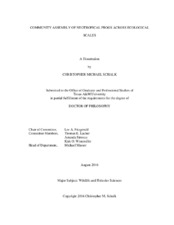| dc.contributor.advisor | Fitzgerald, Lee | |
| dc.creator | Schalk, Christopher Michael | |
| dc.date.accessioned | 2016-09-22T19:39:42Z | |
| dc.date.available | 2018-08-01T05:57:46Z | |
| dc.date.created | 2016-08 | |
| dc.date.issued | 2016-05-18 | |
| dc.date.submitted | August 2016 | |
| dc.identifier.uri | https://hdl.handle.net/1969.1/157929 | |
| dc.description.abstract | Ecological communities are organized by historical, biotic, and abiotic factors and the strengths of these factors vary across multiple spatial and temporal scales. I sought to disentangle the drivers of community assembly in frogs of the Bolivian Gran Chaco. This research was conducted within the framework of Applied Biodiversity Science that incorporates collaborations with local institutions to achieve biodiversity conservation. I used functional traits to examine the relationship between species distribution in niche space and community diversity of post-metamorphic frogs. Community organization was non-random, and species-packing significantly increased with increasing community diversity, a pattern indicative of response to environmental filters. I quantified the spatiotemporal dynamics of pond food webs and observed that consumers were trophic generalists, with many species occupying more than one trophic position. Breeding ponds are patchy and ephemeral across the landscape, and being trophic generalists enables consumers to exploit various resources within a pond. I conducted an experiment to examine predator-induced plastic responses in tadpoles of an arid-adapted species, Leptodactylus bufonius, a species with terrestrial oviposition and aquatic development. Tadpoles in the predator treatments exhibited the strongest responses when exposed to both predator and conspecific alarm cues. Species adapted to breed in ephemeral ponds with terrestrial oviposition may be able to afford reduced growth rates by capitalizing on a head start in development. I examined the relationships between calling activity and environmental factors. Calling phenology of tropical anurans is the product of exogenous factors (i.e., climatic variables) and endogenous factors (i.e., reproductive modes). I also studied intra-specific variation in ambush site selection in metamorphs and adults of Ceratophrys cranwelli. Metamorphs selected a subset of available habitat, whereas adult frogs did not appear to select ambush sites based on variables I measured. This study provides insights to the trade-offs between foraging strategy and mortality risk. A synthesis of the diet in frogs of the Family Ceratophryidae revealed they are generalist, opportunistic predators. Contrary to previously published literature, there is little evidence of larval cannibalism in these species. The results of my dissertation provide important biological information useful in developing conservation strategies needed for habitat management and biodiversity conservation. | en |
| dc.format.mimetype | application/pdf | |
| dc.language.iso | en | |
| dc.subject | Anura | en |
| dc.subject | Bolivia | en |
| dc.subject | Community Structure | en |
| dc.subject | Phenology | en |
| dc.subject | South America | en |
| dc.subject | Gran Chaco | en |
| dc.subject | Community Ecology | en |
| dc.subject | Tadpole | en |
| dc.subject | Environmental Gradients | en |
| dc.subject | Functional Morphology | en |
| dc.subject | Amphibian | en |
| dc.subject | Tropical Ecology | en |
| dc.title | Community Assembly of Neotropical Frogs Across Ecological Scales | en |
| dc.type | Thesis | en |
| thesis.degree.department | Wildlife and Fisheries Sciences | en |
| thesis.degree.discipline | Wildlife and Fisheries Sciences | en |
| thesis.degree.grantor | Texas A & M University | en |
| thesis.degree.name | Doctor of Philosophy | en |
| thesis.degree.level | Doctoral | en |
| dc.contributor.committeeMember | Lacher, Thomas | |
| dc.contributor.committeeMember | Stronza, Amanda | |
| dc.contributor.committeeMember | Winemiller, Kirk | |
| dc.type.material | text | en |
| dc.date.updated | 2016-09-22T19:39:42Z | |
| local.embargo.terms | 2018-08-01 | |
| local.etdauthor.orcid | 0000-0002-9838-7535 | |


